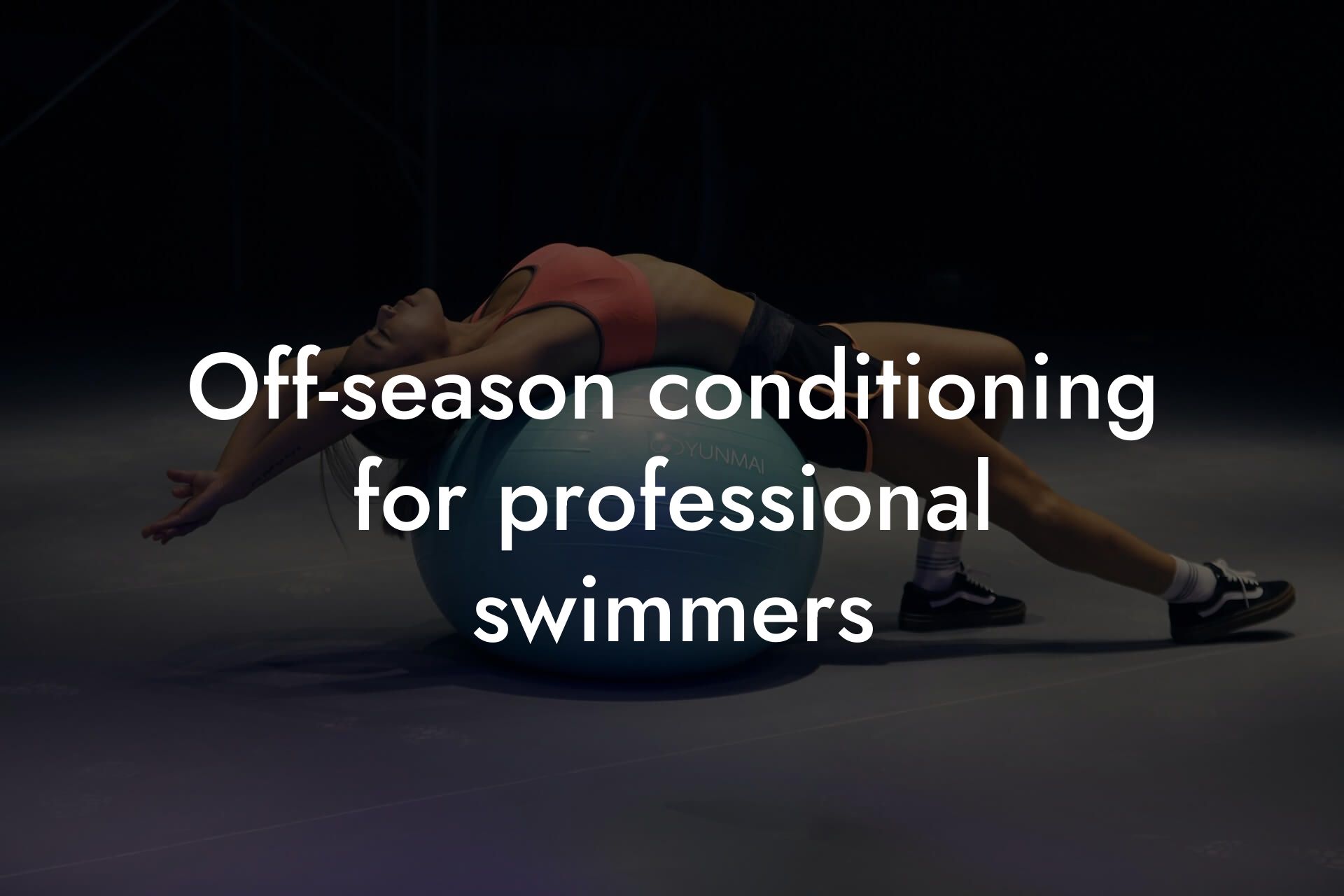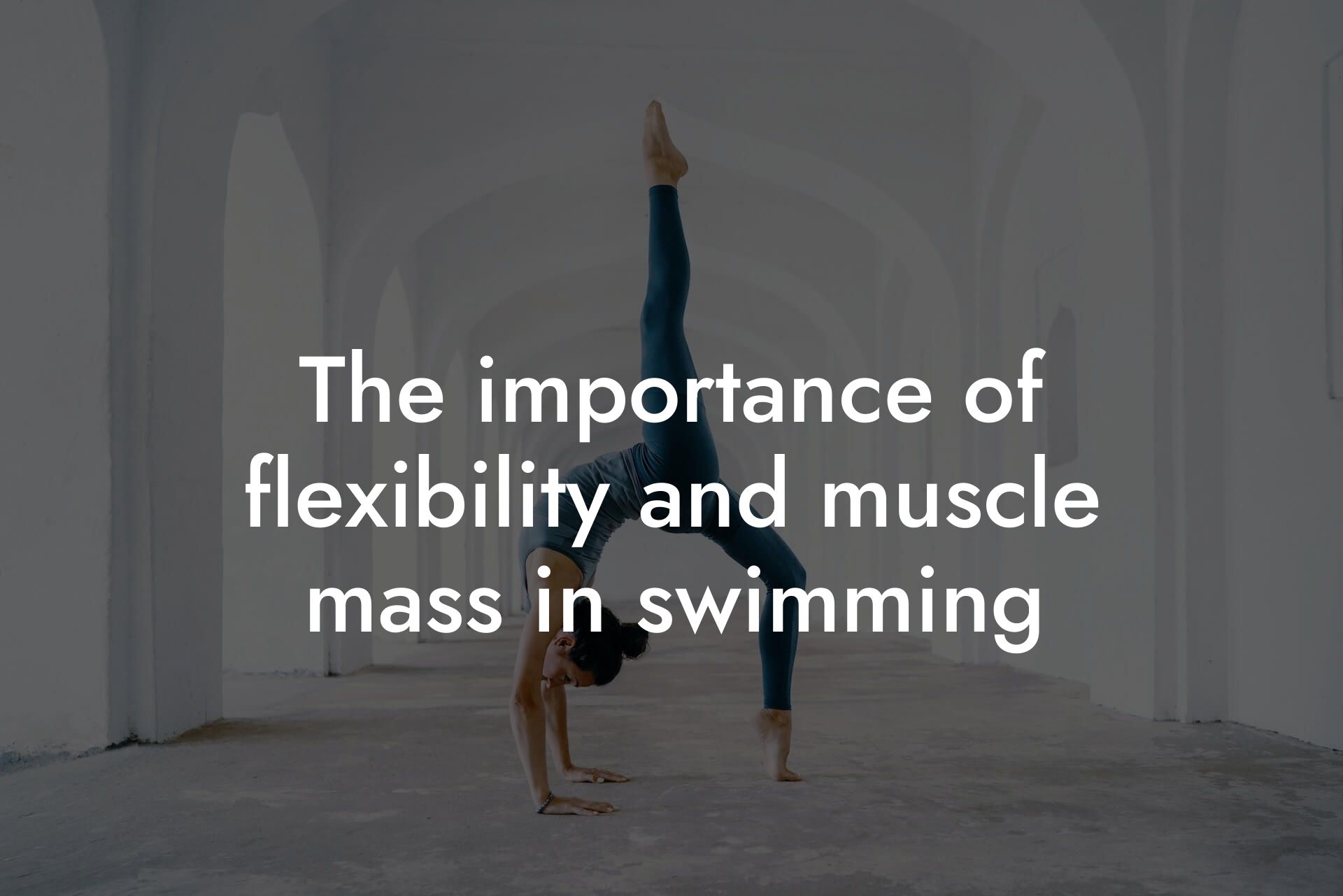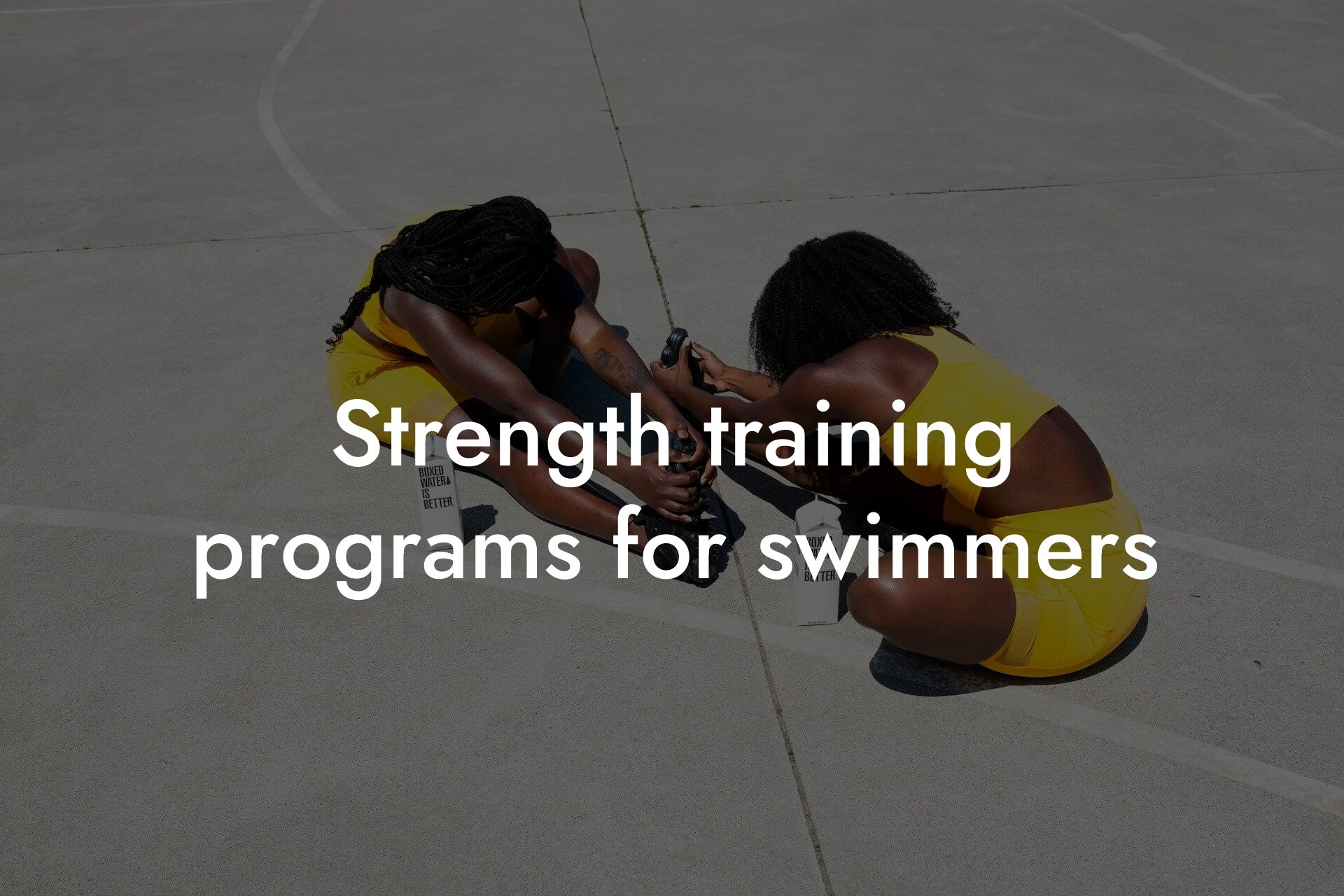As a high-earning professional, you understand the importance of maintaining a healthy and fit physique. Swimming is an excellent way to achieve this, but it requires a delicate balance between strength and endurance. In this article, we'll explore the importance of balancing strength and endurance in swimming, and provide you with the knowledge and tips to take your swimming performance to the next level.
Table of Contents
Understanding Strength and Endurance in Swimming
Strength and endurance are two essential components of swimming performance. Strength refers to the ability to generate power and speed in the water, while endurance refers to the ability to sustain that effort over a prolonged period. Both are crucial for achieving success in swimming, but they require different training approaches and techniques.
Strength training for swimming focuses on building muscular power and explosiveness, particularly in the upper body, legs, and core. This is achieved through exercises such as weightlifting, resistance band training, and plyometrics. Endurance training, on the other hand, focuses on building cardiovascular fitness and increasing stamina, through exercises such as distance swimming, interval training, and aerobic exercises.
The Importance of Balancing Strength and Endurance
Many swimmers make the mistake of focusing too much on one aspect of their training, neglecting the other. However, a balanced approach to strength and endurance training is essential for optimal performance. Here are some reasons why:
A strong swimmer without endurance will fatigue quickly and struggle to maintain their pace over a prolonged period. On the other hand, a swimmer with excellent endurance but lacking in strength will struggle to generate the power and speed needed to compete at a high level.
A balanced approach to strength and endurance training also reduces the risk of injury. Overemphasizing strength training can lead to muscle imbalances and increased risk of injury, while neglecting endurance training can lead to cardiovascular strain and exhaustion.
Assessing Your Current Strength and Endurance Levels
Before you can balance your strength and endurance training, you need to assess your current levels. This can be done through a variety of methods, including:
DEXA scans, such as those offered by Tano Performance Group, provide a comprehensive assessment of your body composition, including muscle mass, bone density, and body fat percentage. This information can help you identify areas where you need to focus your training.
Swim-specific tests, such as the 100m or 200m freestyle, can help you assess your current endurance levels. Strength tests, such as the bench press or pull-up, can help you assess your current strength levels.
Creating a Balanced Training Program
Once you have assessed your current strength and endurance levels, you can create a balanced training program that addresses your weaknesses and builds on your strengths. Here are some tips to get you started:
Split your training into strength-focused days and endurance-focused days. For example, you might do strength training on Monday, Wednesday, and Friday, and endurance training on Tuesday, Thursday, and Saturday.
Incorporate a mix of exercises that target different muscle groups, such as the upper body, legs, and core. This will help you build overall strength and reduce the risk of muscle imbalances.
Incorporate interval training into your endurance workouts. This involves alternating between high-intensity swimming and active recovery, and can help you build both endurance and strength.
Periodization and Progressive Overload
To continue making progress and avoiding plateaus, it's essential to incorporate periodization and progressive overload into your training program. Periodization involves dividing your training into specific phases, each with a different focus and intensity. Progressive overload involves gradually increasing the intensity of your training over time, through increases in weight, reps, or distance.
For example, you might have a strength-focused phase during the off-season, followed by an endurance-focused phase during the pre-season. Within each phase, you would gradually increase the intensity of your training through progressive overload.
Nutrition and Recovery
Nutrition and recovery play a critical role in supporting your strength and endurance training. Here are some tips to help you optimize your nutrition and recovery:
Fuel your body with a balanced diet that includes plenty of protein, complex carbohydrates, and healthy fats. Aim to eat a meal or snack with a mix of these macronutrients within 30-60 minutes of your workout.
Stay hydrated by drinking plenty of water before, during, and after your workouts. Aim to drink at least 8-10 glasses of water per day.
Get enough rest and recovery time. Aim for 7-9 hours of sleep per night, and take rest days as needed. Active recovery techniques, such as foam rolling and stretching, can also help reduce muscle soreness and improve recovery.
Common Mistakes to Avoid
Here are some common mistakes to avoid when balancing strength and endurance in swimming:
Overemphasizing strength training and neglecting endurance training. This can lead to muscle imbalances and a lack of cardiovascular fitness.
Not incorporating enough variety into your training program. This can lead to boredom, burnout, and plateaus.
Not listening to your body and taking rest days as needed. This can lead to injury, exhaustion, and decreased performance.
Balancing strength and endurance in swimming requires a thoughtful and intentional approach to training. By understanding the importance of both strength and endurance, assessing your current levels, creating a balanced training program, and incorporating periodization and progressive overload, you can take your swimming performance to the next level. Remember to also prioritize nutrition and recovery, and avoid common mistakes that can hold you back. With dedication and hard work, you can achieve your goals and become a stronger, faster, and more efficient swimmer.
Frequently Asked Questions
What is the importance of balancing strength and endurance in swimming?
Balancing strength and endurance in swimming is crucial for optimal performance and injury prevention. When you focus solely on building endurance, you may sacrifice strength, leading to poor technique and increased risk of injury. Conversely, building strength without endurance can result in fatigue and poor performance. By balancing both, you'll be able to maintain efficient technique, generate power, and sustain it over a longer period.
How does strength training improve swimming performance?
Strength training enhances swimming performance by increasing muscle power, speed, and efficiency. It also improves your ability to maintain good technique, even when fatigued. By building strength in your shoulders, back, and core, you'll be able to generate more power and propulsion in the water.
What are the benefits of endurance training in swimming?
Endurance training in swimming improves your body's ability to utilize oxygen efficiently, increases your lactate threshold, and enhances your overall cardiovascular fitness. This allows you to sustain a high intensity over a longer period, making you a more efficient and effective swimmer.
How do I know if I'm focusing too much on endurance and neglecting strength?
If you're noticing poor technique, fatigue, or plateaus in your swimming performance, it may be a sign that you're focusing too much on endurance and neglecting strength. Other indicators include increased risk of injury, particularly in the shoulders and knees.
What are some common strength training exercises for swimmers?
Some common strength training exercises for swimmers include push-ups, pull-ups, dumbbell rows, shoulder rotations, and planks. These exercises target the muscles used in swimming, such as the shoulders, back, and core.
How often should I incorporate strength training into my swimming routine?
Aim to incorporate strength training 2-3 times per week, with at least one day of rest in between. This allows for adequate recovery time and prevents overtraining.
What is the ideal ratio of strength to endurance training for swimmers?
The ideal ratio of strength to endurance training for swimmers varies depending on the individual and their goals. A general guideline is to allocate 20-30% of your training time to strength training and 70-80% to endurance training.
How can I incorporate endurance training into my swimming routine?
Incorporate endurance training into your swimming routine by performing longer swims at a moderate intensity. You can also incorporate interval training, where you alternate between high-intensity swimming and active recovery.
What is the difference between aerobic and anaerobic endurance in swimming?
Aerobic endurance refers to your body's ability to utilize oxygen to generate energy, whereas anaerobic endurance refers to your body's ability to generate energy without oxygen. Aerobic endurance is essential for longer swims, while anaerobic endurance is crucial for short, high-intensity sprints.
How can I improve my anaerobic endurance in swimming?
Improve your anaerobic endurance in swimming by incorporating short, high-intensity sprints into your training routine. This can include 25-50 meter sprints at maximum effort, followed by active recovery.
What is the role of core strength in swimming?
Core strength plays a crucial role in swimming by providing stability, generating power, and maintaining good technique. A strong core helps you maintain a streamlined position in the water, reducing drag and increasing efficiency.
How can I improve my core strength for swimming?
Improve your core strength for swimming by incorporating exercises such as planks, Russian twists, and leg raises into your strength training routine. These exercises target the muscles in your core, including your abs, obliques, and lower back.
What is the importance of flexibility and mobility in swimming?
Flexibility and mobility are essential in swimming as they allow for efficient technique and reduce the risk of injury. Good flexibility and mobility enable you to maintain a streamlined position, generate power, and move your arms and legs efficiently through the water.
How can I improve my flexibility and mobility for swimming?
Improve your flexibility and mobility for swimming by incorporating stretching and mobility exercises into your routine. Focus on exercises that target your shoulders, chest, and hips, such as arm circles, chest stretches, and hip flexor stretches.
What is the role of nutrition in balancing strength and endurance in swimming?
Nutrition plays a critical role in balancing strength and endurance in swimming. A well-balanced diet that includes adequate protein, complex carbohydrates, and healthy fats provides the necessary energy and building blocks for optimal performance.
How can I ensure I'm fueling my body adequately for swimming?
Ensure you're fueling your body adequately for swimming by consuming a balanced meal or snack 1-3 hours before training, and refueling with a mix of carbohydrates and protein within 30-60 minutes after training.
What are some common mistakes swimmers make when trying to balance strength and endurance?
Common mistakes swimmers make when trying to balance strength and endurance include neglecting one aspect in favor of the other, overtraining, and failing to incorporate proper recovery techniques.
How can I avoid overtraining and prevent burnout?
Avoid overtraining and prevent burnout by incorporating rest days, active recovery, and cross-training into your routine. Also, listen to your body and take regular breaks to avoid mental and physical exhaustion.
What is the importance of recovery in balancing strength and endurance in swimming?
Recovery is crucial in balancing strength and endurance in swimming as it allows your body to repair and adapt to the physical demands of training. Adequate recovery enables you to perform at a higher intensity and reduces the risk of injury and burnout.
How can I incorporate recovery techniques into my swimming routine?
Incorporate recovery techniques into your swimming routine by incorporating stretching, foam rolling, and self-myofascial release after training. You can also use techniques such as active recovery, compression garments, and cryotherapy to aid in recovery.
What are some common injuries associated with swimming, and how can I prevent them?
Common injuries associated with swimming include shoulder injuries, knee injuries, and lower back strain. Prevent these injuries by incorporating strength training, proper technique, and recovery techniques into your routine.
How can I maintain motivation and consistency in my swimming routine?
Maintain motivation and consistency in your swimming routine by setting realistic goals, tracking your progress, and finding a swimming community or accountability partner. Also, mix up your training routine to avoid boredom and prevent plateaus.
What are some tips for swimmers who are just starting out?
Tips for swimmers who are just starting out include starting slow, focusing on proper technique, and incorporating strength and endurance training into your routine. Also, be patient and celebrate small victories along the way.
Here are some related articles you might love...
- Off-season conditioning for professional swimmers
- The importance of flexibility and muscle mass in swimming
- Strength training programs for swimmers
- Using DEXA scans to optimize swimmer performance
- Bone density and its impact on injury prevention in swimming
- Recovery techniques for swimmers after intense training
- Nutrition strategies for swimmers to maintain energy levels
- The role of body composition in swimming speed and endurance
- Reducing body fat for better buoyancy and speed in swimming
Zak Faulkner
Zak Faulkner is a leading authority in the realm of physical health and body composition analysis, with over 15 years of experience helping professionals optimise their fitness and well-being. As one the experts behind Tano Performance Group, Zak has dedicated his career to providing in-depth, science-backed insights that empower clients to elevate their physical performance and overall health.
With extensive knowledge of DEXA technology, Zak specializes in delivering comprehensive body assessments that offer precise data on body fat, muscle mass, bone density, and overall physique. His expertise enables individuals to make informed decisions and achieve their fitness goals with accuracy and confidence. Zak’s approach is rooted in a deep understanding of human physiology, combined with a passion for helping clients unlock their full potential through personalised strategies.
Over the years, Zak has earned a reputation for his commitment to excellence, precision, and client-focused service. His guidance is trusted by top professionals who demand the best when it comes to their health. Whether advising on fitness programs, nutritional strategies, or long-term wellness plans, Zak Faulkner’s insights are a valuable resource for anyone serious about taking their health and fitness to the next level.
At Tano Performance Group, Zak continues to lead our Content Team revolutionising how professionals approach their physical health, offering unparalleled expertise that drives real results.




